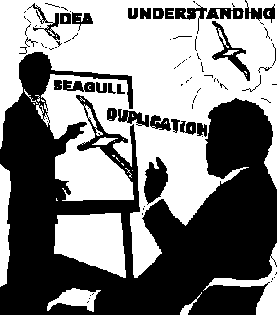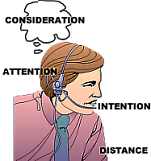|
|
|

The simplest statement of the communication formula
is:
Cause - distance - effect.
There is somebody who speaks (cause).
The somebody speaks to a second person over there (distance).
This second person listens (effect).
It is also defined as: the interchange of ideas
across space.
Another definition is: communication is the
action by which one experiences emotion (A) and by which one obtains
agreement (R).
This definition expresses the function of Communication in the ARC
triangle.
 |
A Consideration is simply a
thought, a postulate, an idea
about something.
But since we have "Mind
over Matter" (Axiom 3)
even concepts as Distance,
Duplication, Intention,
Understanding, Attention, etc.
are called considerations.
|
Yet another definition says: the first and most
basic definition of any part of communication is it's a consideration. As
'duplication' is a consideration, communication is possible to the degree
that the individual can freely make considerations.
The last definition quoted here implies that 'duplication'
is the purpose behind any communication. As 'Cause' you want to make
yourself understood or your orders followed. As 'Effect' you want to
understand or know what to do. What arrives at Effect is the
'Duplication'.
 |
Duplication - Idea at Cause
gets transmitted to Effect.
On a physical level that is:
Compliance or
Copy/Duplicate.
|
 |
| Compliance |
Physical Copy
|
It also says you are as good at communication as
you can make considerations. This may be a little broad for practical use.
But it covers all the small component parts of communication - as well as
the very important factors of making up something to communicate (idea,
message), and the ability of the receiver to duplicate that.
 |
Only live communication
includes Understanding.
The speaker
transmits his idea via a physical
particle to the listener, who is able
to duplicate it and understand it.
(Use the illustrations to
figure out where all the
parts of the formula fit in)
|
From Axiom 28 we have: The
formula of Communication is: Cause, Distance, Effect, with Intention and
Attention, and Duplication with understanding.
Here 'Intention' and 'Attention' are mentioned. In
a live communication the 'Cause' must have Intention for the communication
to be successful. The Cause must pay Attention to the receipt-points
location and condition. 'Attention' is of course also part of being a good
listener, capable of receiving a communication. The action of
communicating has to result in Understanding. The 'Understanding' part is
unique to a live communication.
The full definition of communication is contained in
Axiom 28:
"Communication is the consideration and action
of impelling an impulse or particle from source-point across a distance to
receipt-point, with the intention of bringing into being at the
receipt-point a duplication and understanding of that which emanated from
the source-point."
 |
Components of
live communication.
|
"The formula of Communication is: Cause,
Distance, Effect, with Intention and Attention and Duplication with
Understanding."
"The component parts of Communication are:
Consideration, Intention, Attention, Cause, Source-point, Distance,
Effect, Receipt-point, Duplication, Understanding, the Velocity of the
impulse or particle, Nothingness or Somethingness. A non-communication
consists of Barriers. Barriers consist of Space, Interposition's (such as
walls and screens of fast- moving particles), and Time."
"A communication, by definition, does not
need to be two-way. When a communication is returned, the formula is
repeated, with the receipt-point now becoming a source-point and the
former source-point now becoming a receipt-point."
There is a lot of data here. Let us break it down
and look at the different parts.
We have the main definition:
"Communication is the consideration and action of impelling an
impulse or particle from source-point across a distance to receipt-point,
with the intention of bringing into being at the receipt-point a
duplication and understanding of that which emanated from the
source-point."
Here 'Cause' is called 'Source-point'. That is of
course where the communication starts.
'Effect' is called 'Receipt-point'; that is where
the communication is supposed to arrive.
Source-point has 'the Intention'.
'R. Hubbard defines Intention as 'the carrier wave,
that takes the words along with it.'
Intention is a command factor, a consideration of causatively wanting
something to happen so it happens. It is not the words (or particles).
Intention is in other words a theta quality or ability.
 |
Intention as: a consideration of
causatively wanting something
to happen so it happens.
It's a theta quality.
|
The receipt-point has to have 'Duplication and
Understanding'.
'Duplication' can be a mechanical action. A copy
machine can duplicate.
'Understanding' is a theta quality or ability. It takes a live thetan and
live communication to understand.
We have a particle or impulse. It can be a letter,
an e-mail, a gift, a picture, or even a blow or a bullet, or simply spoken
words. When an understanding is transferred
from one being to another we have a successful communication.
In case of a hostile communication (like, shooting
a bullet) you may not get understanding, but you do get some kind of
duplication (or effect) taking place, so it can be called a
'communication'.
Let us look at the list of 'Component Parts'
We have the physical set-up of Cause -
Distance - Effect. We have a particle. Where do all these parts fit in:
Consideration, Intention, Attention, Cause,
Source-point, Distance, Effect, Receipt-point, Duplication, Understanding,
the Velocity of the impulse or particle, Nothingness or Somethingness. A
non-communication consists of Barriers. Barriers consist of Space,
Interpositions (such as walls and screens of fast-moving particles), and
Time?
We will take them one by one, define them first,
and make some comments.
Consideration is:
(1) a thought, idea, a postulate about something, the message in the
communication.
(2) a continuing postulate (such as 'distance', 'duplication',
'attention', etc.). (3) The highest capability of life, senior to
the mechanics of space, energy and time.
In the comm formula we have the considerations 'Duplication', 'Intention',
'Attention'. Even 'Distance' is a consideration according to definition
(3) above. You see how the concept of Consideration pervades the subject
of Communication.
Definition (1), a thought or idea fits most closely: the idea or message
the Source-point wants to get across and considers that it gets across,
and which the receipt-point considers that it duplicates and understands.
Intention is (1) the
carrier wave that takes the words along with it. And (2) It's a command
factor; a consideration of causatively wanting something to happen so it
happens. (3) It is a theta quality or ability.
This clearly belongs to Source-point. He has an idea or thought and wants
to tell his friend. He uses intention along with the words to get it
across.
 |
 |
 |
|
Too dispersed
|
Too fixed
|
Focused Interest
|
'Attention' is
focused interest. Attention can be aberrated by becoming unfixed and
sweeping; or it can become too fixed upon something, fixation.
The Source-point has to be very aware of (meaning,
have attention out on) the Receipt-point. Source-point has to know where
the Receipt-point is and what the Receipt-point is doing with his or her
attention. Is the Receipt-point ready to receive this communication? What
tone level is best to express this message to this Receipt-point in? And
so on.
'Attention' also refers to the receipt-point. He has to focus with some
interest on Source-point in order to be able to receive his communication.
A good listener would focus with high interest on Source-point and should
be able to do so at will (his interest is not too fixed nor too sweeping).
[If you stare at your pc or are too stiff when you audit your attention is
on yourself; your communication suffers, the ARC in the session suffers,
and the pc suffers.]
Cause, Source-point.
These are synonyms. It is simply the starting point or the point of
emanation of the communication. According to R. Hubbard: "Cause in
our dictionary here means only "source-point."
In TR's, this is the person who speaks.
 |
<Distance>
|

|
|
For a communication to be necessary there has to
be a distance
between Source-point and Receipt-point which has to be overcome.
|
Distance, 1)
The length between two points. 2) The linear space or interval between
point A and point B.
For communication to be necessary there has to be a distance between
Source-point and Receipt-point which one or both has to overcome. If there
were no distance, communication would not be needed as the two points
would occupy the same space. They would also experience total Affinity, as
Cause and Effect would be occupying the same space. Affinity is sometimes
defined as 'consideration of distance'. [In solo-TR's, where a solo
auditor gives commands to himself to execute, the affinity factor is
extremely important.]
Effect, Receipt-point, These
are synonyms. It is simply the ending point of the communication.
In TR's, this is the person who listens.
 |
Perfect
duplication - such as being
able to finish each other's sentences -
often exists between twins. There is
minimum distance, a perfect understanding
and little need for words and physical
particles. This is of course also telepathy.
|
Duplication, is Ideally an exact copy of the original. Also, the
process of making one or many copies. Duplication implies in normal use
that it is a mechanical process. R. Hubbard, however, is often using the
word as meaning: receiving exactly the communication that emanated
from Source-point. 'Perfect Duplication' or 'Perfect Duplicate' is taken
to be total ARC. The tone scale (according to Axiom 25) is a scale of less
and less duplication. According to Axiom 20 a 'Perfect Duplicate' will
cause a condition to vanish in full or in part. Duplication is often a
matter of how you transmit a reality or accomplish agreement.
It belongs clearly to 'Receipt-point' (nonetheless, Source-point has the
responsibility of emanating a message that Receipt-point can make
an exact copy of).
Understanding, According to R. Hubbard, "Understanding is
knowingness in action.", "It is composed of affinity, reality
and communication. And, "Understanding is a sort of a total solvent,
it washes away everything."
When we say 'Understanding' we are talking about a theta quality and
ability. There is no true 'mechanical understanding'. According to the
Axioms the thetan consists of A, R and C = Understanding and is not part
of MEST. Receipt-point exercises his or her A, R, and C to achieve
Understanding; we presume that Source-point took responsibility for
expressing the message in a way that helps Receipt-point to receive it
with A, R, and C and so bring about Understanding.
 |
Too
high velocity
can be deadly.
|
Velocity of the impulse or particle, Velocity means speed.
In verbal communication you can talk too fast or too slow. A speaker has
to make sure to adjust his 'Velocity of particles' to the listener. Too
high a velocity can be deadly - as a bullet is. You can bore a listener to
death by giving him too few ideas too slowly. You can overwhelm her by
giving so many ideas so fast she cant keep up. [As an auditor, you will
drive your pc out of session if you deliver the commands too slowly for
her, or too fast.]
This is the responsibility of the Source-point.
 |
Music is
communication.
Important parts are
rhythm, timing and pauses:
"Nothingness" and
"Somethingness".
|
Nothingness or Somethingness, Spoken communication consists of
sounds and pauses. A good example of 'Nothingness or Somethingness' being
part of communication would be music, with its silences. So is the
transmission of Morse code. A speaker makes statements with pauses in
between, perhaps expecting a response and perhaps not getting it. The
management of Nothingness or Somethingness in the communication is in the
hands of the Source-point.
 |
She stood him up on
a date. She didn't
arrive, due to barriers.
|
A non-communication consists of Barriers. Barriers
consist of Space, Interposition's (such as walls and screens of
fast-moving particles), and Time.
There can be too many barriers to make a
communication successful. 'Too far away'., 'Not in the same room' or
'Missed appointments' could be examples.
The Source-point will have to bring himself into a position where these
factors don't interfere.
Part of this course is to do Axiom 28 in clay. This
analysis is meant as a help to understand the words in the Axiom better
and should make it easier to do the clay demo assignment.
|

























